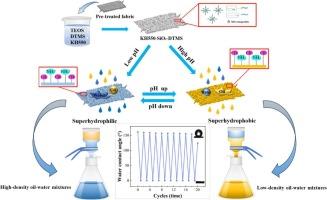一种油水分离性能可控的KH550-SiO2-DTMS纳米复合颗粒可切换润湿性涂层
IF 5.1
3区 工程技术
Q1 CHEMISTRY, APPLIED
引用次数: 0
摘要
智能响应型超润湿涂料因其能够根据环境刺激调节润湿性,实现高效的油水分离而备受关注。本研究提出了一种新颖的ph响应超湿涂层,通过简单、经济的溶胶-凝胶和浸涂方法在棉织物上制备。该涂层结合了低表面能十二烷基三甲氧基硅烷(DTMS)和ph敏感的3-氨基丙基三甲氧基硅烷(KH550)修饰的SiO2纳米颗粒。利用傅里叶变换红外(FTIR)、扫描电镜(SEM)、热重分析(TGA)、x射线光电子能谱(XPS)和水接触角(WCA)对涂层的结构、形貌和性能进行了表征。与现有的pH响应体系相比,该涂层表现出优异的切换速度:它从超疏水性(pH = 7时WCA = 150°)迅速转变为超亲水性(pH = 1时WCA在20 s内从50.24°降至0°),并可逆地回到超疏水性(pH = 13时WCA = 163°)。该涂层在各种盐溶液(NaCl, KCl, KNO3)和超声波洗涤下具有优异的稳定性,确保了在复杂水环境中的坚固性。利用这种可逆的润湿性转换,该涂层在高密度(98.5%)和低密度(96%)油/水混合物中都实现了高分离效率。关键的是,这种制造策略消除了对昂贵的、对环境有害的重金属(例如,银、金、铜)或其他智能分离材料中常用的复杂聚合工艺的需要。快速切换,环境和经济友好,耐盐性,耐久性和高分离性能的结合强调了该涂层在各种实际油/水分离应用中的巨大潜力。本文章由计算机程序翻译,如有差异,请以英文原文为准。

A switchable wettability coating based on KH550-SiO2-DTMS nanocomposite particles with controllable oil-water separation performance
Intelligently responsive super-wetting coatings have garnered significant attention for their ability to modulate wettability in response to environmental stimuli, enabling efficient oil/water separation. This study presents a novel pH-responsive super-wetting coating fabricated via a simple, cost-effective sol-gel and dip-coating approach on cotton fabric. The coating combines low-surface-energy dodecyl trimethoxysilane (DTMS) with pH-sensitive 3-aminopropyl triethoxysilane (KH550) modified SiO2 nanoparticles. The coating's structure, morphology, and properties were characterized using Fourier transform infrared (FTIR), scanning electron microscopy (SEM), thermogravimetric analysis (TGA), X-ray photoelectron spectroscopy (XPS), and water contact angle measurements (WCA). Compared to existing pH-responsive systems, this coating exhibits superior switching speed: it transitions rapidly from superhydrophobicity (WCA > 150° at pH 7) to superhydrophilicity (WCA decreases from 50.24° to 0° within 20 s at pH 1) and reversibly back to superhydrophobicity (WCA = 163° at pH 13). The coating demonstrates excellent stability in various salt solutions (NaCl, KCl, KNO3) and under ultrasonic washing, ensuring robustness in complex aqueous environments. Leveraging this reversible wettability switching, the coating achieves high separation efficiencies for both high-density (98.5 %) and low-density (96 %) oil/water mixtures. Critically, this fabrication strategy eliminates the need for expensive, environmentally hazardous heavy metals (e.g., Ag, Au, Cu) or complex polymerization processes commonly employed in other smart separation materials. The combination of rapid switching, environmental and economic friendliness, salt resistance, durability, and high separation performance underscores the significant potential of this coating for diverse practical oil/water separation applications.
求助全文
通过发布文献求助,成功后即可免费获取论文全文。
去求助
来源期刊

Reactive & Functional Polymers
工程技术-高分子科学
CiteScore
8.90
自引率
5.90%
发文量
259
审稿时长
27 days
期刊介绍:
Reactive & Functional Polymers provides a forum to disseminate original ideas, concepts and developments in the science and technology of polymers with functional groups, which impart specific chemical reactivity or physical, chemical, structural, biological, and pharmacological functionality. The scope covers organic polymers, acting for instance as reagents, catalysts, templates, ion-exchangers, selective sorbents, chelating or antimicrobial agents, drug carriers, sensors, membranes, and hydrogels. This also includes reactive cross-linkable prepolymers and high-performance thermosetting polymers, natural or degradable polymers, conducting polymers, and porous polymers.
Original research articles must contain thorough molecular and material characterization data on synthesis of the above polymers in combination with their applications. Applications include but are not limited to catalysis, water or effluent treatment, separations and recovery, electronics and information storage, energy conversion, encapsulation, or adhesion.
 求助内容:
求助内容: 应助结果提醒方式:
应助结果提醒方式:


